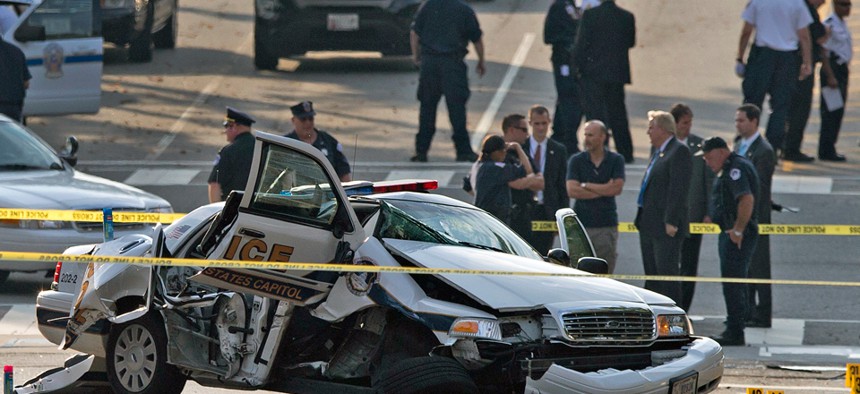Woman Killed in Capitol Hill Chase Was Shot Five Times
Autopsy report shows that Miriam Carey was shot from behind, including once in the head.
Six months after a Connecticut woman was killed in a hail of police gunfire on Capitol Hill, the federal investigation remains under wraps, even as new information has surfaced showing she was shot multiple times from behind, including once in the head.
Three of the five shots that hit Miriam Carey, 34, entered through her back, and another struck her upper left arm, according to the official report of her autopsy, obtained by a lawyer for her family. An accompanying toxicology report shows that Carey, a dental assistant, had no drugs or alcohol in her system when she was killed.
How many of the shots were fired as Carey was still leading police in a car chase from the White House on Oct. 3—with her 14-month-old girl in the rear seat—was not detailed. The report also does not describe whether any shots were fired after her car came to a stop on Capitol Hill, nor does it list the sequence of her wounds.
“It’s been six months now and there’s still nothing from [the Justice Department],” said Eric Sanders, a lawyer for Carey’s family in New York. “But now we have something.”
Sanders contends that law enforcement “blew it,” noting that the documents show Carey was not under the influence of any substances and arguing that she was moving away from the officers at the time she was fatally shot. Law-enforcement officials have consistently declined to comment on the case, citing the ongoing investigation and pending litigation.
Sanders, a former police officer, has already filed a preliminary wrongful-death claim against the federal government, the Secret Service, and the U.S. Capitol Police. Late last week, he posted the autopsy and toxicology documents for public viewing.
Though the case now moves past its six-month anniversary, no official report fully explaining the events of that day has been released from the Justice Department or other law-enforcement agencies.
“The investigation is continuing. And I really can’t provide an estimate as to when it is to be concluded,” said William Miller, a spokesman for the U.S. Attorney’s Office, on Monday. He also would not comment on whether six months is an unusually long time for an investigation of this nature.
Lt. Kimberly Schneider, a spokeswoman for the U.S. Capitol Police, said, “The USCP does not comment on pending litigation and declines to comment while the investigation is ongoing. The USCP officers involved are on administrative leave.”
Other law-enforcement officials did not return calls on Monday. But two House Democrats, who have questioned why it is taking so much time for details of the federal investigation to be announced, said the autopsy information makes them more convinced that the findings should be released publicly.
Rep. Alcee Hastings of Florida, a former federal judge, says he continues to wonder why the car’s tires were not fired upon to stop the vehicle’s progress. He said that investigators should release what they know, but that “I would believe that the hesitancy of the Justice Department is predicated on the fact they know a civil rights lawsuit is coming.”
Rep. Raul Grijalva of Arizona, cochair of the Congressional Progressive Caucus, added that release of the federal findings “would give us a full picture. Suppositions and jumping to conclusions—which nobody wants anybody to do—would be eliminated, and with the whole picture we could draw a real opinion of what happened.”
In an interview Monday, Sanders portrayed the autopsy findings as bolstering his theory that Carey’s shooting was not justified. He said Capitol Police and other law-enforcement officers “panicked” and “completely mishandled” a simple street encounter that began when Carey refused to stop her black Infiniti at a vehicle checkpoint near the White House and made a U-turn.
Sanders said federal agents and officers from multiple jurisdictions began to pursue her car aggressively, and that he is continuing to press for access to police radio transmissions during the incident.
Sanders has yet to explain why Carey was in Washington with her child. But he has previously pointed to documents, including an initial police affidavit which said that after Carey made her turn, a Secret Service officer attempted to block her car with a bicycle rack.
Her car pushed over the rack, knocking the officer to the ground. It was from that point, after the incident at that barrier at 15th Street and Pennsylvania Avenue, that the chase began, and shots were fired as the car continued moving. Carey ultimately was fatally wounded either right before or right after her car came to a halt near the Capitol after circling the Garfield Monument traffic circle. The child, who is now living with her father, was not wounded, despite being in the car’s backseat during at least some of the gunfire.








